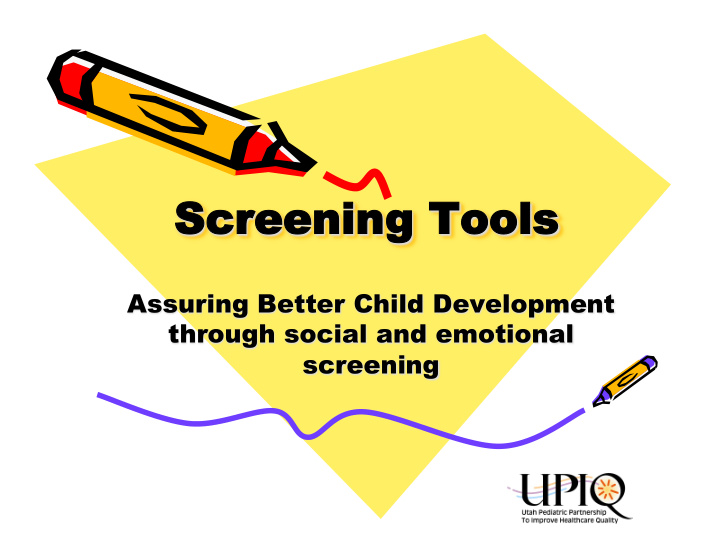



Scr creening eening Tools ools Assuring Better Child Development through social and emotional screening
Partners and Processes • Commonwealth Fund and National Academy for State Health Policy • ABCD II Grant • Guiding principles • Processes
ABCD II Tool Committee • Lori Smith, LCSW • Katie Smart, LCSW • Dr. Polly Sheffield, MD • Dr. Kristina Hindart, MD • Janet Wade • Sue Olsen, MEd
AAP Recommendations • “ The AAP Committee on Children with Disabilities recommends the use of standardized screening tests at well visits. ” • About 16% 16% of children have disabilities including speech and language delays, mental retardation, learning disabilities and emotional/behavioral problems. • Only 30% are detected prior to school entrance.
Screening Overview • Screening - Looks at the whole population to identify those at risk - flags those who need further assessment • Assessment - Determines existence of delay or disability - generates decision regarding intervention • Surveillance - Periodic evaluation of development in relation to the child as a whole
What Can We Do? • Use new, brief, accurate tools • Use parents to help screen • Use Family Centered principles
Mental health screening instrument elements: • Targeted • Sensitivity populations • Specificity • Easy scoring • Reliability • Culturally and • Validity linguistically • Brevity sensitive • Covers age span • Minimal or no cost • Minimal expertise • Easy to administer
Definitions • Sensitivity: the ability of a test to detect a condition when it is truly present – Because we don ’ t want to overlook children who need help • Specificity: the ability of a test to exclude the presence of a condition when it is truly not present – Because we don ’ t want an excess of unnecessary referrals
The Screening Tools • Types of screening include: • Parent Questionnaire • History/Interview • Direct Elicitation • Observation • Desired Sensitivity and Specificity: • 70-80% minimum
What ’ s Possible, What Works ASQ ASQ:SE PEDS TABS BABES NDDS Type/ Parent Parent Parent Parent Parent Direct Questionnaire Questionnaire Questionnaire Questionnaire Questionnaire Elicitation Ages 2 mos–5yrs 6 mos- 6 yrs 0-8 yrs 11- 71 mos Birth-36 mos Birth-36 mos Staff Para-prof Para-prof Para-prof MA or Equiv Para-prof Prof Required Time 5 min 20-30 min 5 min 5 min unknown unknown Cost $190 $190 $3o (pad of 50) $85 Free to .15 for copying Download form or cost (Per Kit) of palm device Sensitivity/ 72 % 71 – 85 % 74 – 80 % 72 % Not Not 86 % 90 – 98 % 74 – 80 % 83 % independently independently Specificity validated validated Language English & English & English & English & English English Spanish Spanish Spanish Spanish French & Vietnamese Korean Hmung, Somali Reading 4 th -6 th Grade 4 th- 6 th Grade 5 th Grade NA Contact NA company Level
Recommended Tools ASQ:SE PEDS TABS ASQ � Type/ � Parent Parent Parent Parent Questionnaire Questionnaire Questionnaire Questionnaire Ages � 2 mos–5yrs 6 mos-6 yrs Birth-8 yrs 11-71 mos Para-prof Para-prof Para-prof MA or Equiv Staff Required Time 5 min 20-30 min 5 min 5 min Cost $190 $190 $3o (pad of 50) $85 (Per Kit) 74 – 80 % Sensitivity/ 72 % 71 – 85 % 72 % 86 % 90 – 98 % 83 % 74 – 80 % Specificity � English & English & English & English & Spanish Language � Spanish Spanish Spanish French & Korean Vietnamese Hmung, Somali 4 th -6 th Grade 4 th- 6 th Grade 5 th Grade NA Reading Level
How is it working? • Utah practices using screening tools • Practices providing helpful hints on implementation • Practices finding improved parent satisfaction • Practices finding other benefits • How do practices get the tools?
Conclusions • Mental Health is a consideration for children from birth to 3-years-old. • Screening and surveillance needs to be a regular part of periodic well care. • It is essential to elicit and listen to family concerns. • Collaborative relationships among providers in the community constitute best practice.
Acknowledgements • Commonwealth Fund • NASHP • Dr. Marian Earls • Tool Selection Committee • UPIQ Partners
• UPIQ Coordinator: Jenifer Lloyd, DVM, MSPH Phone: (801) 585-6480 Fax: (801) 581-3899 Email: jenifer.lloyd@hsc.utah.edu
Speaker Notes • The following slides are for the speaker ’ s reference
Recommended tools • ASQ • ASQ:SE • PEDS • TABS (Temperament and Atypical Behavior Scale)
The ASQ Questionnaire Each questionnaire - Reviews 5 areas q communication q gross motor q fine motor q problem-solving q personal/social. * (Same focus as Early Intervention Program)
The Ages and Stages (ASQ) “ First level screening tool for accurate identification of developmental delays or disorders ” q Original work - 1981. revised 1991, 1994. q Original sample - 2008 q Validation - Gesell, Bayley, Stanford- Binet, McCarthy, Batelle. Overall= 83%. q Sensitivity - 72% q Specificity - 86% Ages Tested- 4-60 months Elicits parent input/concerns
Ages and Stages – SE (ASQ-SE) • Areas screened: self regulation, compliance, communication, adaptive functioning, autonomy, affect, interaction. 30 items. • Sensitivity: 71 – 85% • Specificity: 90 –98 % • Ages: 6 – 60 months • 10 minutes • English and Spanish
Parents Evaluation of Developmental Status (PEDs) • Validation - 771 children • Standardized - 2823 children across the U.S. • Sensitivity: 74 – 80% • Specificity: 70 – 80% • Format - Each questionnarie-reviews 10 items Ø No, yes, and a little are responses. Ø Decision pathways A – E, based on score, to refer or do a second stage screen with ASQ, BINS, Batelle or CDI Ages Tested: 0-8 years Elicits parent input/concerns
Temperament & Atypical Behavior Scales (TABS) • 15 items. To identify temperament and self-regulation problems that indicate risk for developmental delay. • Sensitivity: 72% • Specificity: 83% • 11 –71 months • 5 minutes • English and Spanish
Recommend
More recommend